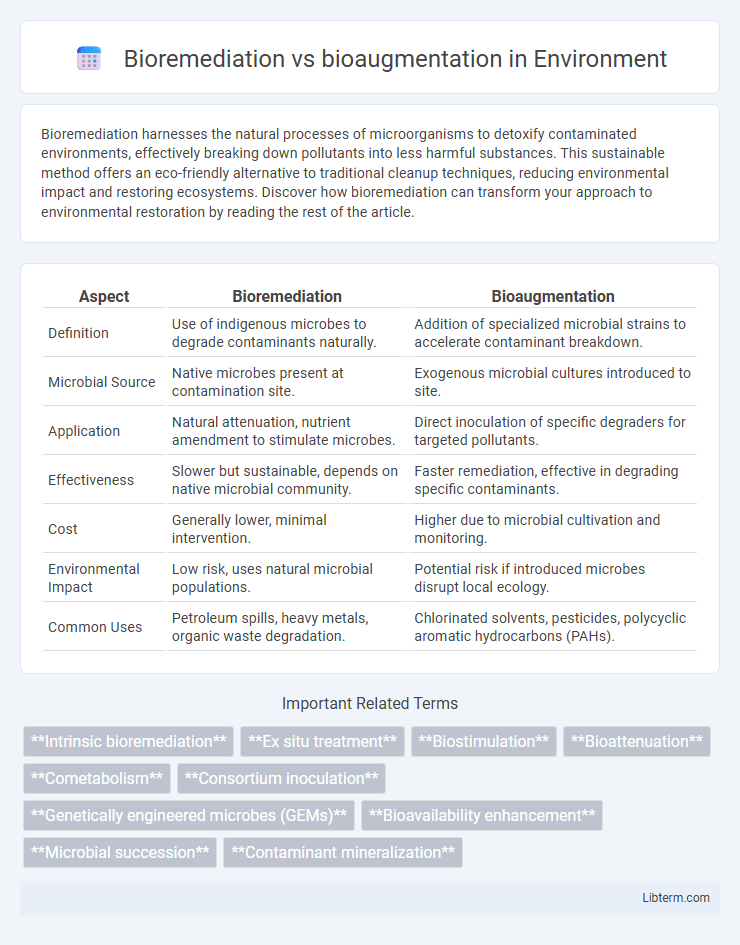Bioremediation harnesses the natural processes of microorganisms to detoxify contaminated environments, effectively breaking down pollutants into less harmful substances. This sustainable method offers an eco-friendly alternative to traditional cleanup techniques, reducing environmental impact and restoring ecosystems. Discover how bioremediation can transform your approach to environmental restoration by reading the rest of the article.
Table of Comparison
| Aspect | Bioremediation | Bioaugmentation |
|---|---|---|
| Definition | Use of indigenous microbes to degrade contaminants naturally. | Addition of specialized microbial strains to accelerate contaminant breakdown. |
| Microbial Source | Native microbes present at contamination site. | Exogenous microbial cultures introduced to site. |
| Application | Natural attenuation, nutrient amendment to stimulate microbes. | Direct inoculation of specific degraders for targeted pollutants. |
| Effectiveness | Slower but sustainable, depends on native microbial community. | Faster remediation, effective in degrading specific contaminants. |
| Cost | Generally lower, minimal intervention. | Higher due to microbial cultivation and monitoring. |
| Environmental Impact | Low risk, uses natural microbial populations. | Potential risk if introduced microbes disrupt local ecology. |
| Common Uses | Petroleum spills, heavy metals, organic waste degradation. | Chlorinated solvents, pesticides, polycyclic aromatic hydrocarbons (PAHs). |
Introduction to Bioremediation and Bioaugmentation
Bioremediation utilizes naturally occurring microorganisms to degrade environmental contaminants, enhancing the natural attenuation processes in soil and water. Bioaugmentation involves the deliberate introduction of specialized microbial strains to accelerate the breakdown of pollutants, especially in sites with insufficient native microbial activity. Both techniques play crucial roles in managing environmental pollution, with bioremediation relying on indigenous microbes and bioaugmentation enhancing microbial capacity through targeted inoculation.
Defining Bioremediation: Principles and Processes
Bioremediation is a process that uses naturally occurring microorganisms, fungi, or plants to degrade or detoxify environmental contaminants into less harmful forms, relying on microbial metabolism to break down pollutants. It involves intrinsic microbial activity to naturally reduce pollutant levels through degradation pathways such as aerobic and anaerobic respiration, enzymatic transformation, and co-metabolism. Key principles include optimizing environmental conditions like pH, nutrient availability, and oxygen levels to enhance microbial efficiency in the cleanup of soil, water, and air contaminated by hazardous substances.
Understanding Bioaugmentation: Key Concepts
Bioaugmentation involves introducing specific strains of microorganisms into contaminated environments to accelerate the degradation of pollutants, complementing natural biodegradation processes. This targeted approach enhances the microbial community's ability to break down complex contaminants such as hydrocarbons, heavy metals, and pesticides. Understanding bioaugmentation requires knowledge of microbial ecology, pollutant chemistry, and environmental conditions to optimize treatment efficacy in soil, water, and wastewater remediation projects.
Types of Bioremediation Techniques
Bioremediation techniques include in situ methods such as natural attenuation, bioventing, and biosparging, which stimulate indigenous microbes to degrade contaminants directly in the environment. Ex situ techniques involve removing contaminated material for treatment using methods like composting, landfarming, and biopiles, enhancing microbial activity under controlled conditions. Bioaugmentation specifically introduces specialized microbial strains to contaminated sites, accelerating the breakdown of pollutants when native microorganisms are insufficient or ineffective.
Mechanisms and Applications of Bioaugmentation
Bioaugmentation involves introducing specific microbial strains or consortia to contaminated environments to enhance the degradation of pollutants, targeting contaminants that native microbes cannot efficiently degrade. This method accelerates the breakdown of complex or toxic substances like petroleum hydrocarbons, chlorinated solvents, and heavy metals by supplementing the existing microbial community with specialized biodegrading organisms. Applications of bioaugmentation are prominent in treating industrial wastewater, soil remediation, and bioreactors, where tailored microbes improve pollutant removal rates and restore ecological balance more effectively than natural bioremediation alone.
Comparative Advantages of Bioremediation and Bioaugmentation
Bioremediation utilizes native microbial communities to naturally degrade contaminants, making it cost-effective and environmentally sustainable for diverse pollution scenarios. Bioaugmentation introduces specialized microbial strains to accelerate pollutant breakdown, offering enhanced effectiveness in sites with limited native biodegraders or complex contaminants. The choice between bioremediation and bioaugmentation depends on site-specific conditions, contaminant types, and desired remediation speed.
Limitations and Challenges in Bioremediation and Bioaugmentation
Bioremediation faces limitations such as environmental variability, including temperature, pH, and nutrient availability, which can hinder microbial activity and pollutant degradation rates. Bioaugmentation challenges include the survival and integration of introduced microbial strains within native ecosystems, often limited by competition, predation, and substrate specificity. Both techniques require careful site assessment and monitoring to optimize performance, yet unpredictable microbial interactions and contaminant complexity frequently restrict effectiveness.
Environmental Impact and Effectiveness
Bioremediation leverages naturally occurring microorganisms to degrade pollutants, minimizing environmental disruption and promoting ecological balance. Bioaugmentation introduces specialized microbial strains to accelerate contaminant breakdown, potentially enhancing cleanup efficiency in heavily polluted sites. Both techniques reduce toxic substances, but bioaugmentation often achieves faster results, while bioremediation emphasizes sustainability and minimal ecological impact.
Case Studies: Success Stories and Lessons Learned
Case studies in bioremediation highlight successful degradation of hydrocarbons in oil-contaminated soils using indigenous microbial communities, demonstrating effective natural attenuation processes. Bioaugmentation case studies reveal enhanced pollutant breakdown when specialized microbial strains, such as Pseudomonas putida, are introduced to accelerate removal of chlorinated solvents in groundwater. Lessons learned emphasize the importance of site-specific microbial compatibility and monitoring to optimize outcomes and prevent unintended ecological disruptions.
Future Trends and Innovations in Bioremediation and Bioaugmentation
Future trends in bioremediation emphasize integrating advanced genomic tools and synthetic biology to enhance microbial efficiency and specificity in pollutant degradation. Innovations in bioaugmentation focus on engineering robust microbial consortia with tailored metabolic pathways for targeted contaminants, improving environmental adaptability and remediation outcomes. Emerging technologies such as CRISPR-based gene editing and high-throughput sequencing are revolutionizing the customization and monitoring of microbial communities in contaminated sites.
Bioremediation Infographic

 libterm.com
libterm.com